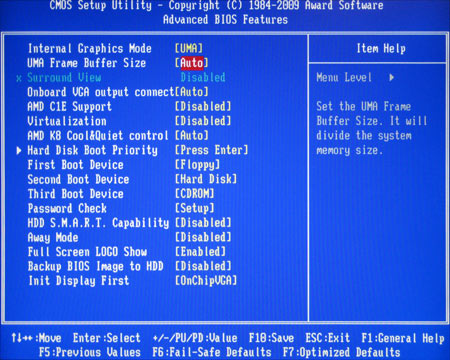Seven AMD 785G-Based Motherboards Rounded Up
Gigabyte GA-MA785GT-UD3H: BIOS And Overclocking
A list of voltage and frequency ranges can be found on page 21 of this review.
Gigabyte's BIOS options are plentiful, with the only missing option of note being southbridge voltage settings. The eight available BIOS profile save slots are more than double that of the next closest competitor in the roundup.
The GA-MA785GT-UD3H managed to dynamically assign system memory to the graphics subsystem without crashing, as it doesn't have any SidePort cache. The other two SidePort-less boards we tested, on the other hand, would crash if resolutions were changed in certain game titles unless the graphics memory was set to a specific value in the BIOS. The Gigabyte board just worked, and we like that.
This board supports DDR3-1800+ memory speeds with “qualified memory modules.” Our Mushkin sticks weren't on the “qualified” list, but we were only shooting for 1,600 MT/s anyway. Unfortunately, the board wouldn't even boot at relaxed timings with this RAM. This is the same RAM that worked at 1,600 MHz on the Asus and ECS boards, so keep in mind that the Gigabyte offering seems to be a little pickier about RAM compatibility
While the board includes AMD's ACC feature, it also offers the flexibility for the user to decide if they would like to try to unlock dormant CPU cores in X2 and X3 processors. If you just turn on ACC, you won't unlock any dormant CPU cores, but you might get the improved overclocking headroom on first-generation Phenom CPUs. However, if you select the hybrid BIOS in addition to ACC, it allows for the core unlocking of capable processors. This is a great feature because most other boards only offer one type of BIOS, either unlocking dormant CPU cores, which might crash an unwilling CPU, or not unlocking dormant CPU cores to allow for more overclocking tolerance on Phenom chips. The hybrid setting allows the user to choose what works best.
We tested this feature and found that it worked perfectly, allowing our Phenom II 550 BE to function with ACC turned on, but without unlocking the two other on-die cores. This same Phenom II X2 550 would otherwise crash when the hybrid BIOS was used with ACC enabled because the dormant CPU cores were faulty. At the same time, the hybrid setting would allow our Phenom II X3 705e sample to run with four cores activated.
Overclocking the GPU yielded 900 MHz at the stock northbridge voltage. Increasing the northbridge voltage seemed to have no effect on the maximum overclock we could achieve, but 900 MHz remains a solid result that we're happy with.
Get Tom's Hardware's best news and in-depth reviews, straight to your inbox.
Current page: Gigabyte GA-MA785GT-UD3H: BIOS And Overclocking
Prev Page Gigabyte GA-MA785GT-UD3H: Features And Hardware Next Page ECS A785GM-M: Features And HardwareDon Woligroski was a former senior hardware editor for Tom's Hardware. He has covered a wide range of PC hardware topics, including CPUs, GPUs, system building, and emerging technologies.
-
JohnnyLucky Very informative article. Nice to see there are motherboards with different features for different users/tasks.Reply -
bpdski Great article, I think this shows pretty conclusively that there is no benefit to upgrading to an AM3 based system. If you already have an AM2+ system, you can easily just drop in a new CPU and you system will be every bit as good as a brand new system with DDR3. You just need to make sure your motherboard supports the power requirements of whatever you want to drop in.Reply -
jonpaul37 Hooray AMD for having cheap solutions in these hard-economic times!Reply
Boo @ Intel! i like the product, but my wallet & Girl do not like the cost! -
jonpaul37Hooray AMD for having cheap solutions in these hard-economic times!Boo @ Intel! i like the product, but my wallet & Girl do not like the cost!+1Reply
Girl has more money for clothes! -
ominous prime Well bpdski there is no point upgrading if you're AM2, but if you're building a new PC AM3 is the way to go in terms of your computers longevity. Very informative article.Reply -
sonofliberty08 thanks alot for the info , my first choice was allways asus , but now i now what i need when im going to unlock core , and now i saw the benefits of sideport memory .Reply -
duzcizgi ReplyWe were successful in achieving a 900 MHz stable overclock with the integrated graphics chipset by setting the BIOS to increase northbridge voltage by +.210mV.
Well, .210 mV = 210 microvolt. I don't think it would make much of a change. Maybe it is 210 mV or, .210 V. :) -
doron "Now we're seeing another benefit for the AM2+/DDR2 boards: both the Foxconn Cinema Premium and Biostar TA785GE 128M are drawing less power than their AM3/DDR3 counterparts."Reply
How comes? Didn't we all agree a long time ago that ddr3 supposed to be more energy efficient out of the two? (Lower voltage and stuff?) -
DarkMantle Great article, this will help a lot of people to make their AMD budget motherboard choice easier, thank you Don.Reply


